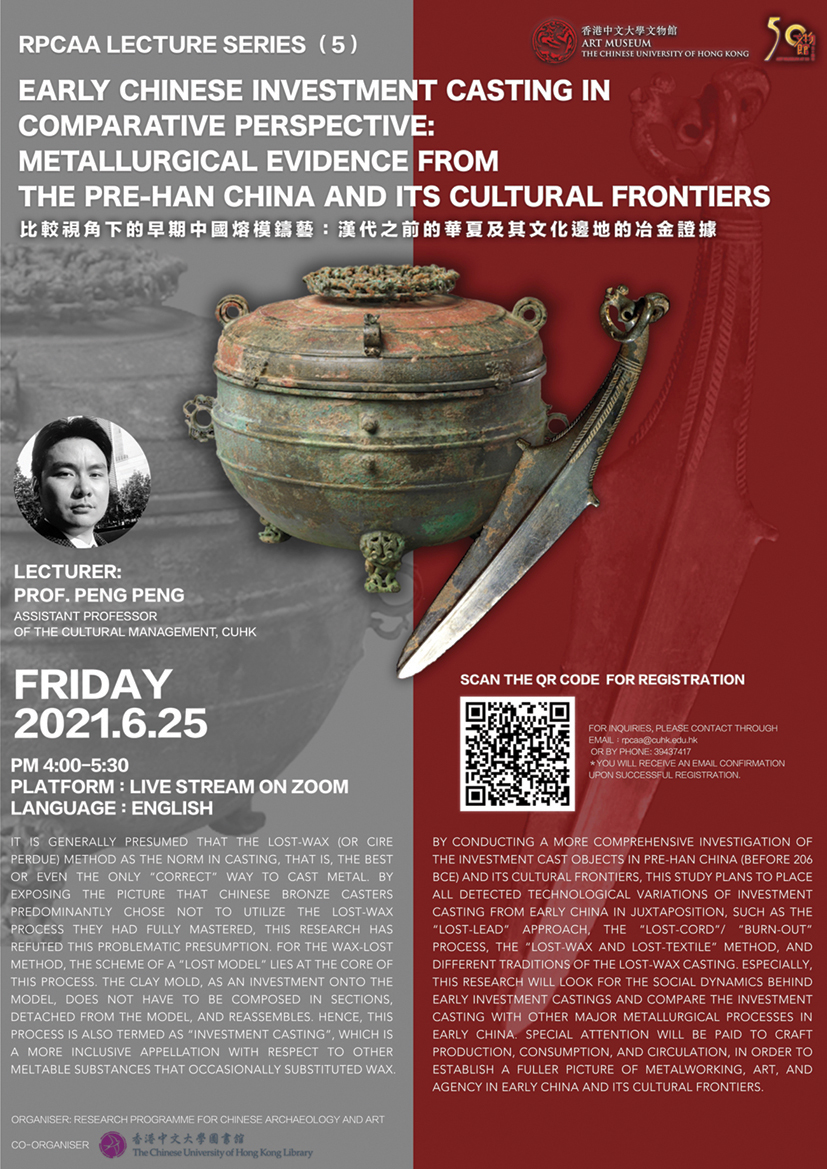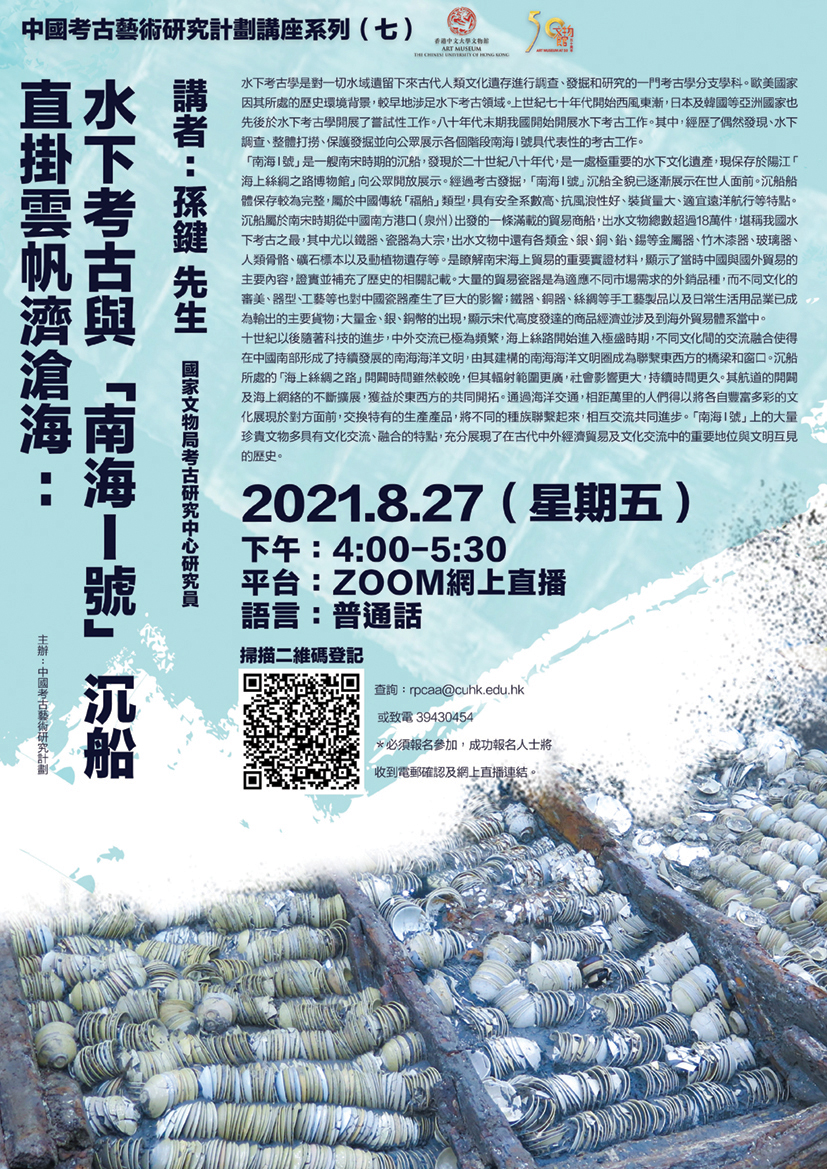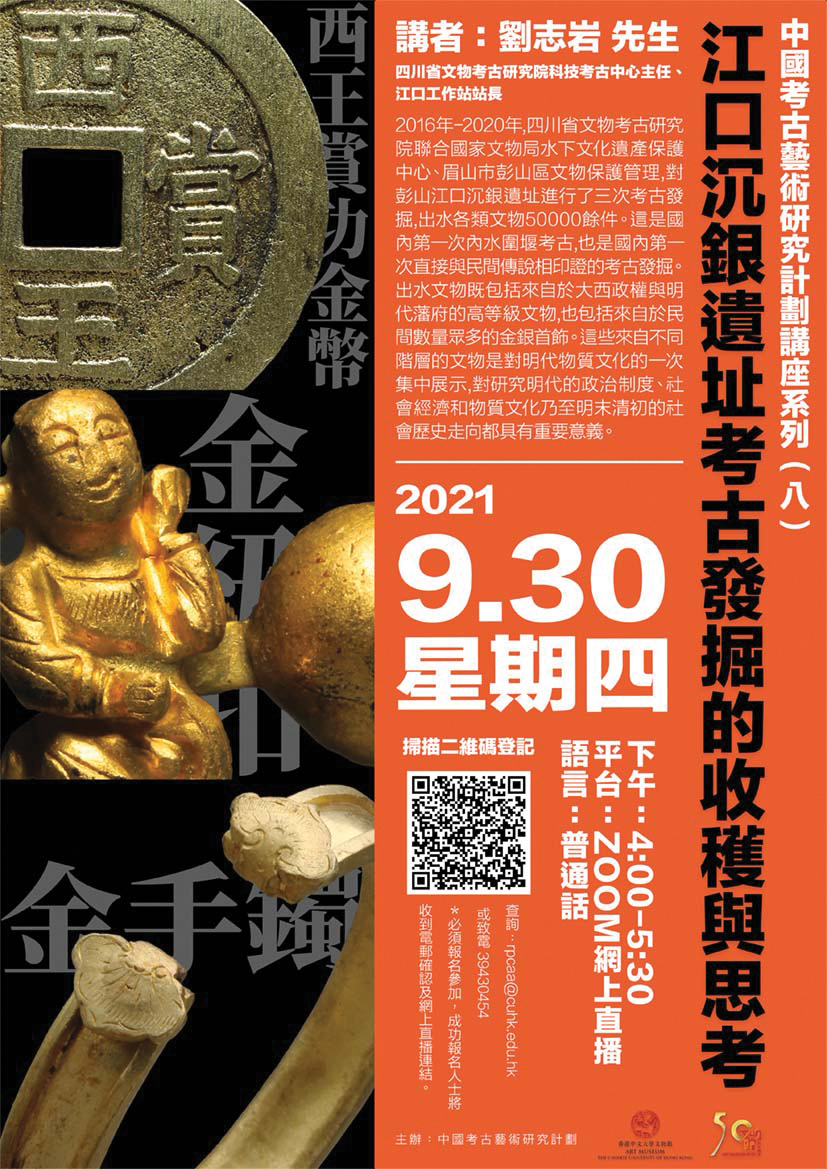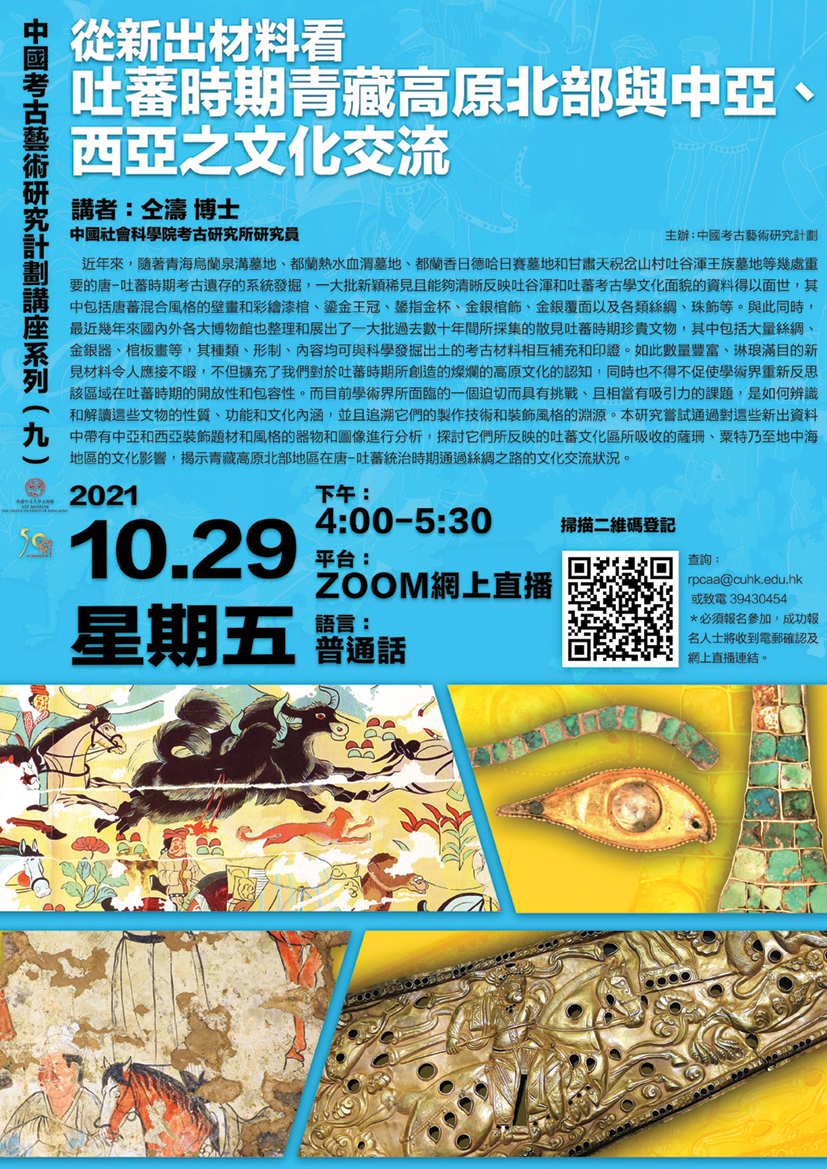RPCAA Lecture Series (5)
Early Chinese Investment Casting in Comparative Perspective: Metallurgical Evidence from the Pre-Han China and Its Cultural Frontiers

Prof. Peng Peng, Assistant Professor of the Cultural Management of CUHK, was invited to deliver his lecture on 25 June 2021. Prof. Peng’s research centres on the art, archaeology, and visual and material cultures of ancient East Asia.
The speaker first introduced the “lost-wax” (or cire perdue) method, which is generally presumed as the norm in casting, that is, the best or even the only “correct” way to cast metal. By exposing the picture that Chinese bronze casters predominantly chose not to utilize the lost-wax process they had fully mastered, Prof. Peng’s research has refuted this problematic presumption. The scheme of a “lost model” lies at the core of the lost-wax method. The clay mould, as an investment onto the model, does not have to be composed in sections, detached from the model, and reassembled. Hence, this process is also termed “investment casting,” which is a more inclusive appellation with respect to other meltable substances that occasionally substituted wax.
This lecture presented a comprehensive investigation of the investment cast objects in pre-Han China (before 206bce) and compared the technical differences of early Chinese investment casting methods (e.g. various traditional methods of “lost-wax” casting, the possibly existing "lost-lead" approach, the “lost-cord”/“burn-out” process, and the “lost-wax and lost-textile” method). The lecture also discussed extensively about the origin of these investment casting processes in China.
This lecture is the first English lecture in this series and has attracted many overseas audiences, including the United States, the Netherlands, and Malaysia. The highest number of participants online at the same time reached 48 people. The audience also actively asked questions after the presentation and the response from the crowd was excellent.
RPCAA Lecture Series (6)
The New Ruling Order and Reconstruction of the Bronze Industry in the Han’s Southern Frontiers: Cases Studies of Bronzes from Hunan and Northern Vietnam
Prof. Lam Weng Cheong, the Assistant Professor of History/Anthropology of CUHK, was invited to deliver his lecture on 30 July 2021. Prof. Lam mainly conducts archaeology working in mainland China. By incorporating various archaeological techniques, his research focuses on the economic system and social development during the Bronze Age and Han Empire.
During the Wudi’s reign, the Han dynasty launched series of military campaigns in Lingnan and incorporated the used-to-be peripheries into the Huaxia system. Previous studies on archaeological discoveries in Han’s southern frontiers often focus on the issues of migration and assimilation evidenced by burial records as well as the establishment of ruling towns. Yet, the integration of local societies into the new imperial system has long been overlooked.
In this lecture, the speaker introduced his projects in Chenzhou (southern Hunan) and Hanoi (northern Vietnam) with regard to the transformation of the bronze production system before and after the establishment of the Han Empire. The speaker particularly introduced how scientific analysis of bronzes can shed new light on the relationship between political changes and production system of daily goods.
The total number of participants in this lecture was around 200. It was the most diverse group of audience we ever had in this seminar series, with participants from Hong Kong, mainland China, Taiwan, Germany, Malaysia, the Netherlands, Macau, Japan, the United States, France, the United Kingdom, and Australia.
RPCAA Lecture Series (7)
Hoist the Sails to Cross the Sea — Underwater Archaeology and the Nanhai No.1 Shipwreck

Mr Sun Jian, the Research Fellow of the National Centre of Archaeology, was invited to deliver his lecture on 27 August 2021. The lecture was mainly about the Nanhai No.1 Shipwreck in the Southern Song dynasty. It was discovered in the 1980s and is regarded as a very important underwater cultural heritage. It is now preserved in the Maritime Silk Road Museum in Yangjiang, which is open to the public.
The hull of the shipwreck is relatively intact. It belongs to the traditional Chinese “Fujian ship”. It was a fully loaded merchant ship that set off from the southern range port of China (Quanzhou) during the Southern Song dynasty. Over 180,000 cultural relics were raised from the water, which is the greatest underwater archaeological discovery in China. Among them, ironware and porcelain are the major relics. Other relics include various metalware like gold, silver, copper, lead, and tin, bamboo and wood lacquerware, glassware, human bones, specimens of ores, and the historical remains of animals and plants. Most of them showed the characteristics of cultural exchanges and integration. They provide critical empirical evidence for understanding the maritime trade of the Southern Song dynasty and the history of mutual civilization, which can confirm and supplement the related historical records. Although the "Maritime Silk Road" where the shipwreck is located was opened late, it has created a greater and more lasting social impact.
The lecture series has received excellent reviews. 137 participants attended this lecture. Most participants have expressed a strong interest in underwater archaeology. They actively asked questions and exchanged ideas after the presentation.
RPCAA Lecture Series (8)
Archaeological Discoveries and Exploration in the Jiangkou Shenyin

Mr Liu Zhiyan, the Director of the Science and Technology Archaeology Centre of the Sichuan Provincial Cultural Relics and Archaeology Research Institute and the Head of the archaeological excavation project of the Shenyin Site in Jiangkou, was invited to deliver his lecture on 30 September 2021.
From 2016 to 2020, three archaeological excavations were conducted at the Jiangkou Shenyin Site in Pengshan by the Sichuan Provincial Cultural Relics and Archaeology Research Institute, the Underwater Cultural Heritage Protection Centre of the National Cultural Heritage Administration, and the Pengshan Cultural Relics Protection and Management Office of Meishan. Over 50,000 cultural relics of all kinds were raised from the water. This is the first inner water cofferdam archaeology and the first archaeological excavation that is directly corroborated by folklore in China. The cultural relics include not only high-level relics from the Daxi regime and the Ming dynasty, but also a large number of gold and silver jewellery from the folks.
These cultural relics from different classes are able to showcase the material culture of the Ming dynasty. They are of great significance to the research on the political system, social economy, and material culture of the Ming dynasty, as well as the social and historical development of the late Ming and early Qing dynasties.
This lecture attracted more than 100 people to participate online. After the presentation, the audience actively engaged in the Q&A session, which enhanced the participants’ understanding and interest in the archaeological discoveries of the site.
RPCAA Lecture Series (9)
New Archaeological Findings and the Cultural Exchange between the North Qinghai–Tibet Plateau and the Central & Western Asia during the Tibetan Period
Dr. Tong Tao, the researcher of the Institute of Archaeology, Chinese Academy of Social Sciences, was invited to deliver his lecture on 29 October 2021.
In recent years, along with the systematic excavations of several important Tang–Tubo archaeological remains, such as the Qinghai Ulanquangou tomb, Dulan Rexuewei tomb, Dulan Xiangride Harisai tomb, and Tuyuhun royal tomb in Chashan Village at Tianzhu, Gansu, a large number of novel and rare materials that can clearly reflect the cultural features of Tuyuhun and Tubo archaeology are coming out, including frescoes and painted lacquered coffins in a mixture of Tang and Tibetan styles, gilt crowns, golden cups, gold and silver coffin decorations, as well as various silks and jewellery.
At the same time, local and overseas museums have also exhibited a large number of rare cultural relics of the Tubo period collected in the past few decades, including a large number of silks, gold and silverwares, and coffin paintings. Their types, shapes, and contents can be mutually supplemented with the archaeological materials unearthed from scientific excavations.
The speaker shared that he tried to analyse the artefacts and images with Central and Western Asian decorative themes and styles in these new materials, and examined the cultural influences of Sassanian, Sogdian, and even the Mediterranean region absorbed by the Tubo cultural region. It can reveal the cultural exchange through the Silk Road in the North Qinghai–Tibet Plateau during the Tang–Tubo period.
This lecture was once again invited to be broadcasted on the programme "University Knowledge Platform” by RTHK.
|

















